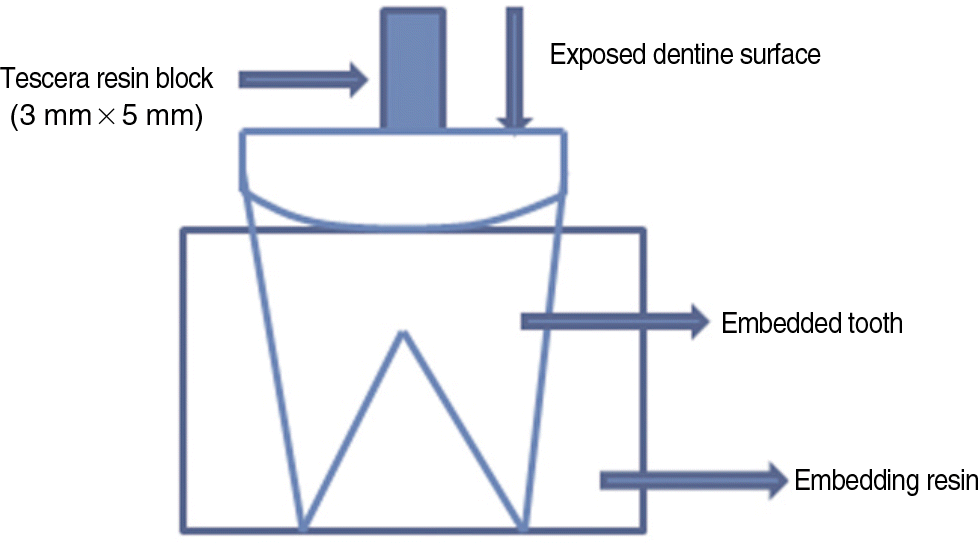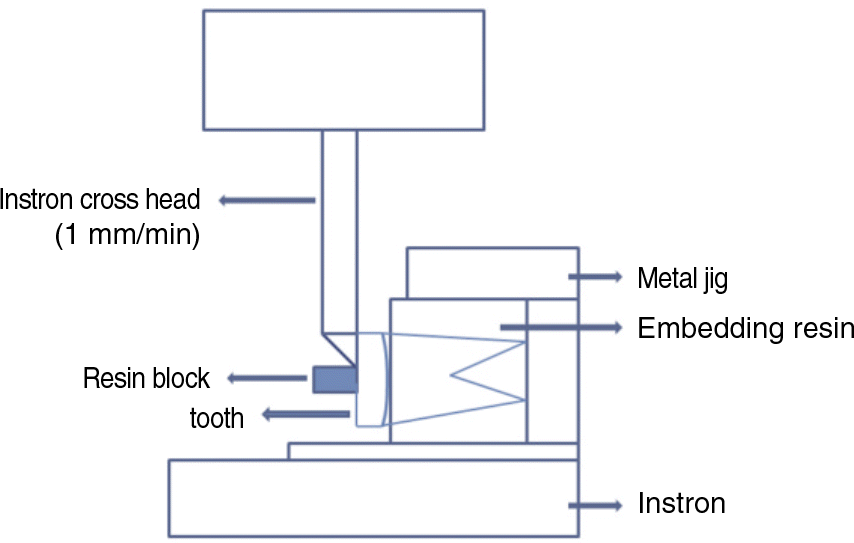Abstract
Purpose
The aims of this study were to evaluate the effect of a resin coating on the shear bond strength of indirect composite restoration bonded to dentin with a self adhesive resin cement and to compare the shear bond strength with that of a conventional resin cement.
Materials and methods
The occlusal enamels of thirty six extracted non-carious human molars were removed until the dentin flat surfaces of the teeth were exposed. Then, they were divided into 3 groups. The dentin surfaces of group 1 and 3 were left without any conditioning, while the dentin surfaces of group 2 were resin-coated with Clearfil SE bond and a flowable resin composite, Metafil Flo. After all specimens were temporized for 24 hours, indirect composite resin blocks fabricated by Tescera were bonded to dentins by Unicem for group 1 and 2, and by Panavia F for group 3. After 48 hours of water storage, shear bond strengths were measured. The data was analyzed with one-way analysis of variance and multiple comparison test (Tukey method).
Go to : 
REFERENCES
1.Tyas MJ., Anusavice KJ., Frencken JE., Mount GJ. Minimal intervention dentistry-a review. FDI Commission Project 1-97. Int Dent J. 2000. 50:1–12.
2.de Andrade OS., de Goes MF., Montes MA. Marginal adaptation and microtensile bond strength of composite indirect restorations bonded to dentin treated with adhesive and low-viscosity composite. Dent Mater. 2007. 23:279–87.

3.Maruoka R., Nikaido T., Ikeda M., Ishizuka T., Foxton RM., Tagami J. Coronal leakage inhibition in endodontically treated teeth using resin-coating technique. Dent Mater J. 2006. 25:97–103.

4.Islam MR., Takada T., Weerasinghe DS., Uzzaman MA., Foxton RM., Nikaido T., Tagami J. Effect of resin coating on adhesion of composite crown restoration. Dent Mater J. 2006. 25:272–9.

5.Hashimoto M., Sano H., Yoshida E., Hori M., Kaga M., Oguchi H., Pashley DH. Effects of multiple adhesive coatings on dentin bonding. Oper Dent. 2004. 29:416–23.
6.Burgess JO., Ghuman T., Cakir D. Self-adhesive resin cements. J Esthet Restor Dent. 2010. 22:412–9.

7.Wissenschaftliches Produktdossier RelyX Unicem. 3M ESPE AG, 82229 Seefeld, Germany.
8.Benelli EM., Serra MC., Rodrigues AL Jr., Cury JA. In situ anticariogenic potential of glass ionomer cement. Caries Res. 1993. 27:280–4.
9.Yang B., Ludwig K., Adelung R., Kern M. Microtensile bond strength of three luting resins to human regional dentin. Dent Mater. 2006. 22:45–56.

10.Song MH., Park SJ., Cho HG., Hwang YC., Oh WM., Hwang IN. Influence of adhesive application on shear bond strength of the resin cement to indirect resin composite. J Korean Acad Cons Dent. 2008. 33:419–27.

11.Kang SI., Park JK., Hur B., Kim HC. Effect of the additional etching procedure on push-out bonding strength of one-step resin cement. J Korean Acad Cons Dent. 2008. 33:443–51.
12.Ferracane JL., Stansbury JW., Burke FJ. Self-adhesive resin cements - chemistry, properties and clinical considerations. J Oral Rehabil. 2011. 38:295–314.

13.Abo-Hamar SE., Hiller KA., Jung H., Federlin M., Friedl KH., Schmalz G. Bond strength of a new universal self-adhesive resin luting cement to dentin and enamel. Clin Oral Investig. 2005. 9:161–7.

14.Holderegger C., Sailer I., Schuhmacher C., Schla¨pfer R., Ha¨- mmerle C., Fischer J. Shear bond strength of resin cements to human dentin. Dent Mater. 2008. 247:944–50.

15.De Munck J., Vargas M., Van Landuyt K., Hikita K., Lambrechts P., Van Meerbeek B. Bonding of an auto-adhesive luting material to enamel and dentin. Dent Mater. 2004. 20:963–71.
16.Kumbuloglu O., Lassila LV., User A., Vallittu PK. A study of the physical and chemical properties of four resin composite luting cements. Int J Prosthodont. 2004. 17:357–63.
17.Shin HJ., Song CK., Park SH., Kim WJ., Cho KM. Physical Properties of different self-adhesive resin cements and their shear bond strength on lithium disilicate ceramic and dentin. J Korean Acad Cons Dent. 2009. 34:184–191.

18.Nikaido T., Nakaoki Y., Ogata M., Foxton R., Tagami J. The resin-coating technique. Effect of a single-step bonding system on dentin bond strengths. J Adhes Dent. 2003. 5:293–300.
19.Takahashi R., Nikaido T., Ariyoshi M., Foxton RM., Tagami J. Microtensile bond strengths of a dual-cure resin cement to dentin resin-coated with an all-in-one adhesive system using two curing modes. Dent Mater J. 2010. 29:268–76.

20.Yoshikawa T., Sano H., Burrow MF., Tagami J., Pashley DH. Effects of dentin depth and cavity configuration on bond strength. J Dent Res. 1999. 78:898–905.

21.Kemp-Scholte CM., Davidson CL. Marginal integrity related to bond strength and strain capacity of composite resin restorative systems. J Prosthet Dent. 1990. 64:658–64.

22.Jayasooriya PR., Pereira PN., Nikaido T., Burrow MF., Tagami J. The effect of a "resin coating" on the interfacial adaptation of composite inlays. Oper Dent. 2003. 28:28–35.
23.Kim TG., Lee KW., Yu MK. The effect of temporary filling materials on the adhesion between dentin adhesive-coated surface and resin inlay. J Korean Acad Cons Dent. 2008. 33:553–9.

24.Cho NY., Lee IB. Polymerization shrinkage, hycgroscopic expansion and microleakage of resin-based temporary filling materials. J Korean Acad Cons Dent. 2008. 33:115–24.
Go to : 
Table 1.
Composition of resin cements used in this study
Table 2.
Group classification




 PDF
PDF ePub
ePub Citation
Citation Print
Print




 XML Download
XML Download